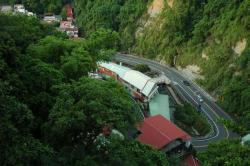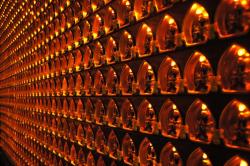After breakfast we took a rather less spectacular if twice as fast, twice as comfortable and comparatively half-priced bus back to Chiayi, passing through countless tea plantations and road construction sites. Once there, we hauled our bags through the sweltering streets (oh, how I missed the cool weather already) to the little local bus terminal which had buses to Guanzihling, our next destination, with just enough time to grab a final turkey rice and some bubble/pearl/boba tea — milky tea with chewy tapioca balls, a Taiwanese invention that was a huge Asia-wide boom a while back and is even starting to make headway in the Americas.
The bus eventually did show up, and having been pre-baked in the sun it was hot as a sauna inside. Being a local service, it took over an hour to crawl through suburban Chiayi, past the indistinguishable neighboring town of Baihe, just a little way back up the mountain, through a twisty valley, and into a parking lot which turned out to be the line’s terminus. Our hotel wasn’t in sight, the solitary map plonked on the parking lot was useless, there was no signage in any language, the people at the hotel didn’t appear to be capable of explaining where on earth they were and I didn’t have the Chinese characters of the hotel’s name anywhere. Arrgh. Stretching our combined Mandarin skills to the max, we managed to convey to the bus driver that we wanted to go to “Toong Mao”, and he waved us uphill — where, after a 5-minute trodge, we did find our hotel. Not much English (or Japanese) was spoken there either, but they did manage to get us checked in and we crashed into our first bed in four nights that didn’t feel like it had the sheets nailed to plywood. Unlike at Alishan, where our room had scenic views of the parking lot, the Toong Mao is built atop a hill and has great views down into the valley where “old” Guanzihling lies, a steep 300-step staircase away.
Guanziling has an unusual claim to fame: it’s one of only three places on earth (the others being Kagoshima in Kyushu, Japan and Vulcano in Sicily, Italy) that features muddy hot springs, meaning that the hot spring water coming out the ground is already premixed with fine grey silt as it comes out. Not too exciting if you’re a guy, perhaps, but Z — whose delicate skin doesn’t always share our mutual conviction that a perpetually hot and humid tropical climate is greatest thing since sliced bread — was very keen on trying it out.
So here’s how you do it. Strip to your swimsuit, take a shower, put on a shower cap to protect your hair, maybe even goggles if you’re hardcore, and then start slathering on the mud, great big buckets of which are provided. Cover every inch of your body with gray goop — the Toong Mao resort even provides sex-segregated spaces if you want to take that literally and dispose of the swimsuit — then take a seat and wait for a few minutes until it starts to dry and the surface takes on a light gray sheen. Then go sit in a warm pool of the stuff, rinse it off, and repeat as often as you’d like. Regrettably (if unsurprisingly), no cameras are allowed, but here’s a blog by somebody whose resort did allow it:
4travel.jp/traveler/eijiiigle/album/10053442/
And does it work? I can’t voucher for the male of the species, but for the ladies, the answer is an unqualified “yes”. I have no idea why or how that mud works — it’s really, really, really fine, so maybe it’s actually sinking into your pores and clogging them up? — but it certainly feels mm-mm-smooth.
Dinner at a nearby restaurant was simple but excellent: amazing river shrimp deep-fried whole, cold bamboo shoots in sesame oil, tofu with bean sauce and a complimentary dish of steamed mountain veggies. The day’s “you know you’ve been in Asia too long” moment came when Z said “oh look, protein”, plucked out a stiff inch-long caterpillar from her veggies, deposited it on the side of the plate and continued eating. And so did I.
Up next: Taipei













